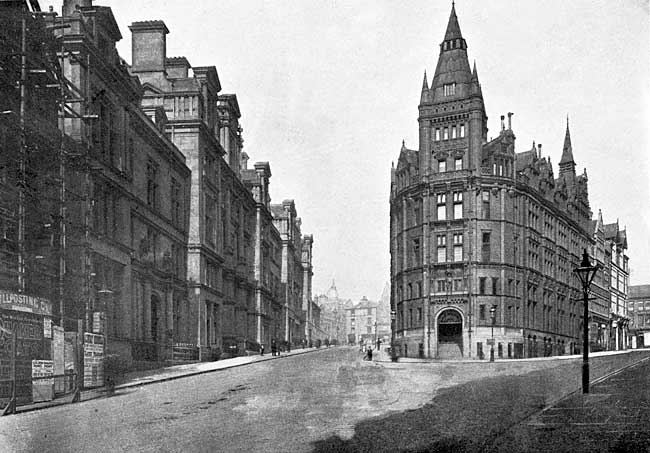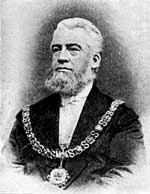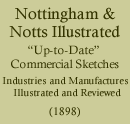< Previous | Contents | Next >

King Street from the Market Place.
![]() O the student of national progress, or to that far larger community of the public interested in the advance of commercial, industrial, and municipal movements making for the advantage of our country, few English towns present more striking features to the historian than the ancient city to which this review of Nottingham, past and present, is dedicated. The scene of many stirring incidents in the earlier period of its history, passing through vicissitudes more numerous perhaps than has been the common lot of its provincial contemporaries, the City has since adopted those gentler arts of peaceful industry which alone provide the fabric of enduring prosperity in communities as in nations.
O the student of national progress, or to that far larger community of the public interested in the advance of commercial, industrial, and municipal movements making for the advantage of our country, few English towns present more striking features to the historian than the ancient city to which this review of Nottingham, past and present, is dedicated. The scene of many stirring incidents in the earlier period of its history, passing through vicissitudes more numerous perhaps than has been the common lot of its provincial contemporaries, the City has since adopted those gentler arts of peaceful industry which alone provide the fabric of enduring prosperity in communities as in nations.

The late Sir J. Oldknow, Mayor of Nottingham 1869, 1877. 1878, and 1879.
More immediately concerned with the present than the past, a brief retrospect of the earlier events in the history of the City will suffice the purpose of our work. According to that widely-accepted authority—Wylie and Briscoe's "Popular History of Nottingham," the town dates back to a remote period, Rowe asserting that it was founded in B.C. 950; and Leland states that Nottingham was one of the four cities founded by Lucius, son of Helena. Its importance in Saxon times is amply evidenced by documents proving that the town formed a portion of the Kingdom of Mercia, in the Saxon Heptarchy, some time about the end of the sixth century. Five centuries later the town was burnt; but on the accession of Henry II., that monarch assisted in the work of repairing the mischief wrought by his soldiers, and from time to time Parliaments were held here and important state business transacted.
During the reign of Henry VIII., in 1534, Nottingham was made a suffragan bishopric, and was therefore created a city; while a few years later one of the most important events in its history—the invention of the stocking-knitting machine by the Rev. William Lee, of the neighbouring village of Calverton—laid the foundation of one of its principal staple industries, since developed to the enormous benefit of the inhabitants.
1674 saw the erection of the present Castle, commenced by the Duke of Newcastle, and finished about 1680, to which future reference will be found when dealing with that portion of our subject. In 1710 printing was introduced by William Ayscough, the earliest production of typographical art,—other than newspapers,—bearing date 1712.
From this period the story of industrial development is a continuous record of improvements designed to enhance the productions of the cotton, hosiery and lace trades. Briefly summarised these were as follows:—In 1758, the Derby rib machine was introduced ; in 1767, Hargreaves, the inventor of the spinning jenny, sought refuge, and established the first cotton mill in the world at Nottingham; and about 1773, the point-net-lace making was introduced by a poor artisan named Flint. With the opening of the present century a new era of prosperity may be said to have dawned for the city, which at that time occupied but an area of some mile and three-quarters in circumference ; and despite visitations of pestilence and famine of unprecedented severity at the commencement, the subsequent years may be said to have been redundantly fruitful of progressive movements tending to the constant improvement of the social and municipal life of the town.
